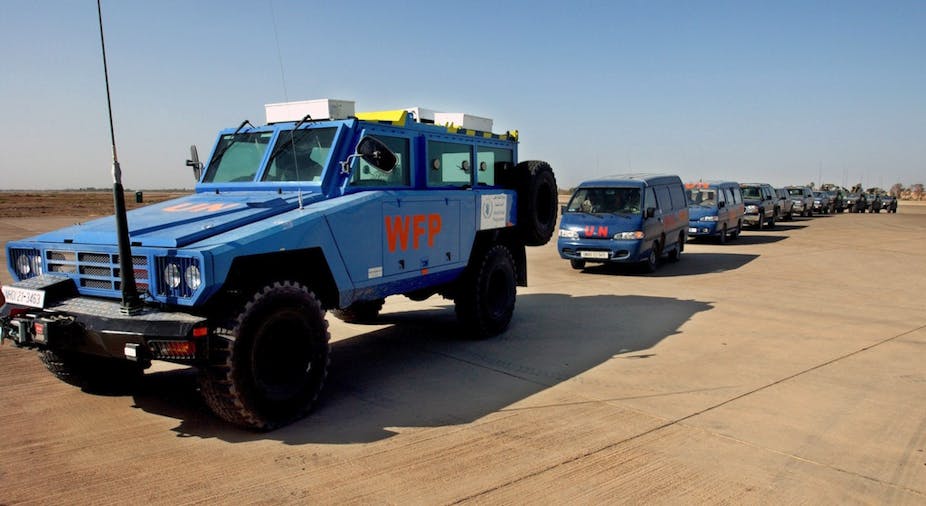The hostilities in Syria have killed hundreds of thousands and displaced millions. Every day, people die because they lack goods and services essential for their survival. Much of the suffering is a consequence of the violence of the past three years, but the failure of aid efforts to relieve the accompanying humanitarian crisis has undoubtedly contributed.
With the suffering showing no signs of abating, and the violence expected to escalate in the coming days in response to the presidential elections, we need to reconsider how aid operations are being carried out in Syria.
In particular, we need to ask whether the use of humanitarian corridors – arguably the most controversial yet potentially most effective of all assistance models – can help get life-saving aid to the Syrian people.
Humanitarian corridors are strips of land, sea or air that are demilitarised to allow aid convoys safe and rapid entry into particular areas of a conflict zone (often besieged cities with large civilian populations). Corridors are established in a certain location for a specified length of time and are then closed. Some reopen regularly in the same place; others never open in the same place more than once. If well-negotiated and sufficiently protected, these corridors provide a highly structured and swift way of delivering aid. And, in the face of frequent attacks on aid workers, they also render that delivery much safer.
Why the controversy?
For a number of reasons, many are wary of humanitarian corridors. Especially troubling is that, on the rare occasion corridors have been used, they have not escaped the usual politicisation and corruption rife in conflicts. In the 2009 Gaza War, for example, aid delivered through IDF-established corridors was stolen and sold to merchants affiliated to Hamas. But that is not the only concern. International law usually gives us answers (though not always satisfactory ones) to questions involving armed conflicts and the responsibilities that States have towards their people, but the law (as it stands) cannot give us certainty here.
We know, for example, that corridors are most effective when they are established with the consent of the respective parties. In fact, under international law, the Geneva Conventions and Additional Protocols (rules of warfare for the protection of civilians) stipulate that aid can be delivered only if the receiving state consents.
But we do not know, legally speaking at least, whether there are circumstances under which corridors can be established in the absence of that consent. Can we bypass the requirement of state consent if the humanitarian crisis is severe enough? We simply do not know for sure. And because we do not know, there remain concerning legal implications for States and organisations that try to deliver aid without consent.
Seen in that light, it is hardly surprising there is such resistance to establishing aid corridors.
Time to reconsider

The deteriorating situation in Syria ought to make us think twice about our resistance to humanitarian corridors. If we get humanitarian corridors right, we have a much better chance of getting aid to those who need it. Yes there are concerns, but is it not the case that corridors actually exhibit the same politicisation and corruption vulnerabilities that we accept in other aid mechanisms? And if we spent more time on important questions regarding state consent, for example, would we not have better legal guidance to give to conflict-affected governments?
With that in mind, let us recall the fact that the Syrian government has not actually placed a blanket ban on assistance. What the government has done is to restrict the distribution of assistance (albeit to the point of delivery becoming near impossible). That restriction, however, is justified to an extent on the basis of legitimate military concerns that uncontrolled aid could be diverted from civilians and used to support the opposition. The problem is, we do not know – legally at least – to what extent that restriction is permissible. This, evidently, is problematic.
It is at this point that humanitarian corridors have a lot to offer compared to other mechanisms of aid delivery, such as airdrops or mass shipment of goods. Whether we like it or not, we have to accept that the Syrian government has, under international law, the right to control the aid coming into its territory. If the international community violates those rights by delivering aid without consent, the Syrian authorities seem perfectly placed to arrest aid workers and confiscate consignments, even if the workers are instructed by organisations like the United Nations and even if the shipments contain life-saving supplies like food and medicine.
To avoid those situations, we need to ensure that aid delivery reflects the military and security interests of the Syrian government as much as it reflects the interests of those needing, and indeed providing, the assistance.
Humanitarian corridors could well give us this opportunity. Why? Because they not only encourage active engagement and balancing of interests but they rely upon the successful negotiation of such for their existence. If interests are balanced, the Syrian government is much less likely to restrict or ban aid distribution.
There are millions of people in Syria who desperately need assistance and humanitarian corridors might allow us to go some way to accessing those people. They certainly would not solve everything, but a reconsideration of their use might prove beneficial nonetheless.

